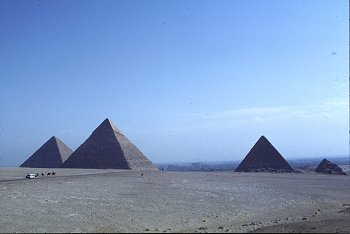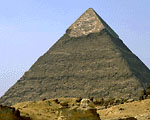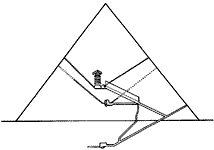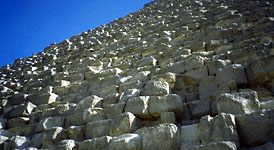Giza
Pyramids
| |
Egyptology Articles
Herbs and Aroma
Alternative
Medicine
Aroma Therapy
|
|
The Pyramids
of Egypt, built at Giza during the 4th Dynasty are the oldest of the
seven wonders and the only ones remaining intact today . The three great
pyramids and six small pyramids are situated on the left bank of the
Nile in Cairo. The pyramids
earlier than Giza are Step pyramid of King Zoser in Saqqara (early III
Dynasty), Step pyramid in Medum (III-IV Dynasty), the pyramid in Dahshur
(IV Dynasty) and others.
Giza pyramids were built by three pharaohs - Cheops
(or Khufu*), Chephren
(Khafre*) and Mycerinus
(Menkaure*) - during the second half of the third millennium
B.C.
-
The Pyramid of Cheops is 230.364m square at
base, 137.18m height (originally 146m) and the incline is 51 degree .52.
-
The Pyramid of Chephren is 215.8m square at
base, 136.5m height (originally 143.5m)and the incline is 53 degree .20.
-
The Pyramid of Mycerinus is 108.5m square at
base, 66.5m height and the incline is 51 degree.
|
 |
|
The Great
Pyramid of Cheops, the largest of the three at Giza, is estimated to
comprise as many as 2.5 million limestone blocks with an average weight
estimated at 2.5 tonnes (2.5 tons). The entire structure was encased in a fine
white polished limestone brought from the hills at Tura, on the opposite side of
the Nile.
|

|

|
This highly prized material was removed in the 16th
century and used to decorate mosques in Cairo.
When
completed, the Great Pyramid stood 146.6 metres (481 feet) tall, and its base
was 230.3 metres (756 feet) square. The capstones (pyramidions) of all the
pyramids were made of solid polished granite
|
The Great
Pyramid of Khufu (circa 2600 BC) was the greatest of the Egyptian pyramids,
which served as burial places of the pharaohs, particularly during the Old
Kingdom.
The
great pyramids of Giza were built around 2700-2500 BC as tombs for the pharoahs
(rulers of ancient Egypt, who held the status of gods on earth). The Great
Pyramid of Khufu (Cheops to the Greeks) is the largest,pictured here in the
center of the photograph, it covers 13 acres. It was constructed of around 2.3
million stones and each of the stones weigh from 2 to 30 tons each.
|
 |
|
|
The
granite slab that is the roof of Khufu's burial chamber weighs 50 tons in
itself. Khufu's pyramid stands about 450 feet (137 meters) high. It is also in
almost complete form, despite being the World’s oldest Wonder. The pyramid of
King Chephren is behind Khufu's and the pyramid of King Mycerinus is in front.
The three smaller pyramids in the front were built for King Mycerinus’ three
wives.
These
monumental pyramids are precisely oriented to the four cardinal points. Today
the city of Cairo reaches almost to the foot of the pyramids, but when the
pyramids were built, they were in the middle of the desert. The Great Pyramids
of Giza still have a strong impact on humanity. The impact is best summed up in
this ancient Arab proverb: "Man fears Time, yet Time fears the
pyramid."
The great pyramid is believed to
have been built over a period 20 year. The site was first prepared, and blocks
of stone were transported and placed. An outer casing (which disappeared over
the years) was then used to smooth the surface. Although it is not known how the
blocks were put in place, several theories have been proposed. One theory
involves the construction of a straight or spiral ramp that was raised as the
construction proceeded. This ramp, coated with mud and water, eased the
displacement of the blocks which were pushed (or pulled) into place. A second
theory suggests that the blocks were placed using long levers with a short
angled foot.
The Great Pyramid was 145.75 m (481 ft) high when it was
built. Over the years, it lost 10 m (30 ft) off its top. It ranked as the
tallest structure on Earth for more than 43 centuries, only to be surpassed in
height in the nineteenth century AD. It is made composed of 2,300,000 blocks of
stone, each averaging 2 1/2 tons in weight. Despite the makers' limited
surveying tools no side is more than 8 inches different in length than another,
and the whole structure is perfectly oriented to the points of the compass.
It was covered with a casing of
stones to smooth its surface (some of the casing can still be seen near the top
of Khefre's pyramid). The sloping angle of its sides is 51 degrees and 51
minutes.
Each side is carefully oriented
with one of the cardinal points of the compass, that is, north, south, east, and
west. The horizontal cross section of the pyramid is square at any level, with
each side measuring 229 m (751 ft) in length. The maximum error between side
lengths is astonishingly less than 0.1%. On the north face, is the pyramid's
entrance. A number of corridors, galleries, and escape shafts either lead to the
King's burial chamber, or were intended to serve other functions.
At the moment, only the Great Pyramid is open to the
public. (For conservation reasons, the others are closed.) After climbing a
number of steps, one enters through a narrow passage on the north side. This
passage leads to a sloping corridor with a low ceiling where one is obliged to
bend over while climbing up a ramp. The ramp leads to a passage with a high
ceiling called the Grand Gallery, from where stairs lead to the king's burial
chamber. Good walking shoes and light clothes are advised for anyone entering
the pyramid. The climb is strenuous and the narrow passages tend to trap the
heat.
|
The king's burial chamber is
located in the middle of the pyramid, high above ground, and a series of
relieving chambers were built above it to prevent it from collapsing.
|

|
|
|
|
You may freely reprint this article
or place it on your website by
adding this statement: Courtesy of www.kingtutshop.com
|





